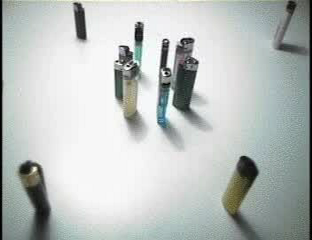
the "lighter side" (1998)
It was 1998. We had a party (dude) at the house that I shared with a buddy, and in the process of cleaning up, I found an alarming number of cigarette lighters around our basement.
At some point within the weeks after the party, I found that I had:
- Many cigarette lighters
- The house to myself for an entire Saturday
- A clear tabletop (atypical, but I'd just cleaned up)
- a crappy little video camera
- A Snappy Video Snapshot
- A computer
Of course, given these things, I had no other choice but to make a stop-motion video of the "Grand Ball Of The Cigarette Lighters".
As far as I remember, it started out doing an Esther-Williams-Bathing-Beauty-esque sort of geometrical kaleidoscope thing, but somehow, it developed a plot along the line.
I'm not going to try to remember most of the production details, but I had a freeware program to make individual images into an AVI file. I simply set up a capture program so that I could click a mouse to take a picture. As I recall it was a ball mouse, and I took the ball out so I could click without worrying about moving the pointer off of the capture button.
Snappy, as it was, took something like 10 or 20 seconds to digitize and send an image anyways, so the procedure was
Things I learned or figured out:
The credits were done with a Perl script, running on Linux, and the PBMPLUS utilities. If you want to deal with large numbers of frames, etc, you may want to look into all three. Another common package for image manipulation under Linux is ImageMagick, which is pretty cool, I used it on this web site for a while to auto-monochrome all uploaded pictures (This was at the time a completely colorless website).
Another video that is inidicative of my playing around in the same period is woody.mpg. "Woody" was the computer in the picture (named after Toy Story's Woody the Cowboy). I had a frame capture set up on a Sun Workstation, using a shell script to 1) beep 2) wait 10 seconds, 3) take a frame 4) repeat. So each time it beeped, I would move and wait for the next beep...